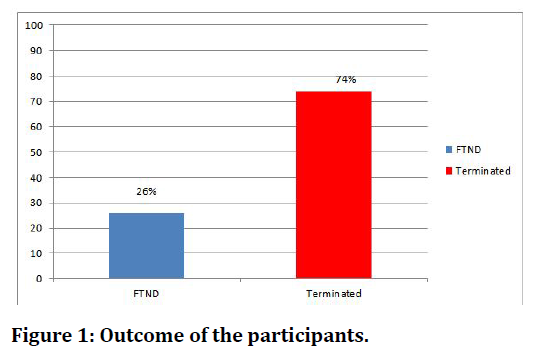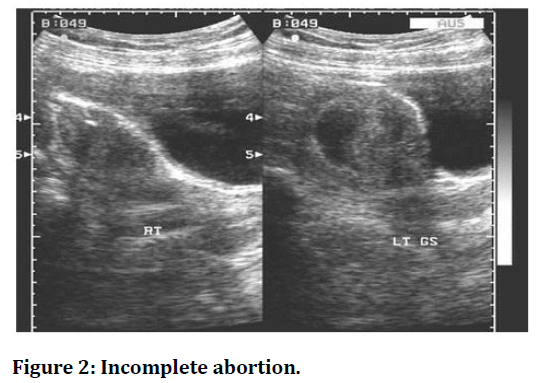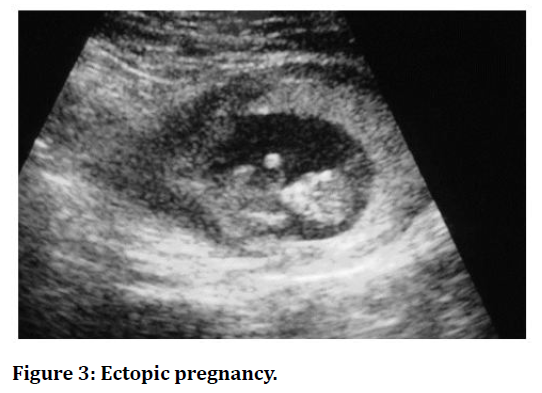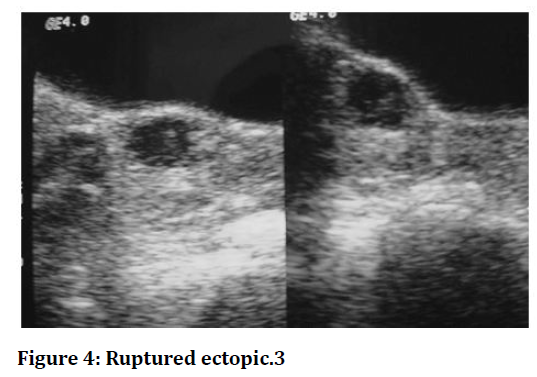Research - (2021) Volume 9, Issue 10
Role of Ultrasound in Evaluation of Vaginal Bleeding in First Trimester of Pregnancy
*Correspondence: Jagadeswari, Department of Gynaecology & Obstetrics, Sree Balaji Medical College and Hospital, India, Email:
Abstract
In the first trimester of pregnancy, bleeding from the vagina is the most common obstetric issue that leads to hospital admissions, causing both the patient and the obstetrician to be nervous and worried. The common causes of bleeding in the first trimester of pregnancy include different forms of abortions, ectopic pregnancy, and molar pregnancy. The cause and prognosis of first trimester bleeding cannot be definitely evaluated by eliciting the relevant history and pelvic examination. Objective of our study was to determine the causes of bleeding per vagina in first trimester of pregnancy and to evaluate the sensitivity and specificity of Ultrasound in diagnosing the cause of first trimester vaginal bleeding.
Keywords
Pregnancy, Trimester, Abortions
Introduction
In the first trimester of pregnancy, bleeding from the vagina is the most common obstetric issue that leads to hospital admissions, causing both the patient and the obstetrician to be nervous and worried. It is also one of the most important explanations for the bulk of the obstetrics department's emergency admissions. A complex phase covering ovulation, fertilization, implantation and organogenesis is the first trimester. In the early months of labour, 20-25 percent of pregnant women will experience some degree of bleeding. In a given patient, the importance of bleeding in early pregnancy can vary from an inconsistent episode to a life-threatening emergency. The first trimester, which requires close monitoring of the foetus and the mother, is the most important time in the antenatal period. In determining the causes of first trimester bleeding, ultrasound (both abdominal and TVS) plays an important role in prognosticating and predicting the status of abnormal pregnancies. Real-time sonography is a non-invasive and readily accessible approach that is highly beneficial for a specific diagnosis to be achieved. The age of marriage for women has risen with the recent changes in culture and social life, leading to an increase in maternal age. The family's population has declined as well. The likelihood that patients will have a normal pregnancy outcome has increased. These things placed increased pressure on physicians, especially obstetricians, to produce normal results. Hence, more importance is given to Ultrasonography for diagnosis and assessing prognosis of first trimester vaginal bleeding. Sensitivity, specificity, PPV, NPV and accuracy were calculated. A P value below 0.05 was considered as statistically significant. Ethical approval was obtained from the Institutional Ethics Committee. Informed written consent was obtained from the participants. Participants were assured about confidentiality of the participants data [1-7].
Methodology and Results
13 out of 19 sonologically confirmed cases of threatened abortion were followed up to term gestation with successful outcome. 6 cases of threatened abortion were terminated on follow-up with 2 cases as complete abortion, 2 cases as missed abortion and 2 cases with repeat bleeding showed incomplete abortion. Out of 19 sonologically confirmed cases of threatened abortion were followed up to term gestation with successful outcome. 6 cases of threatened abortion were terminated on followup with 2 cases as complete abortion, 2 cases as missed abortion and 2 cases with repeat bleeding showed incomplete abortion.
The gestational age of majority (56%) of the participants were in between 8 to 10 weeks. Abortion was the major cause of bleeding contributing to 82%. These was a disparity of 42% between clinical and sonologically diagnosis. All the cases of threatened abortion (19 cases), incomplete abortion (11 cases), missed abortion (3 cases), blighted ovum (1 case) and molar pregnancy (3 cases) were correctly diagnosed on ultrasonography. Diagnosis by ultrasound could not identify one case of ectopic pregnancy which was misdiagnosed as complete abortion (Figures 1 to Figure 4).

Figure 1. Outcome of the participants.

Figure 2. Incomplete abortion.

Figure 3. Ectopic pregnancy.

Figure 4. Ruptured ectopic.
Discussion
In the first trimester, nearly twenty-five percent of all pregnant women complaints of bleeding. For them, many medical possibilities should be taken into account, and there are several causes of bleeding that cover a variety of conditions ranging from viable pregnancy to nonviable pregnancy. To give a definitive diagnosis, clinical history and evaluation are not enough. In delivering a definitive diagnosis; ultrasonography has become a blessing for obstetricians, so that special care, medical or surgical, can be instituted immediately. A correct (viable or non-viable) diagnosis of the nature of the pregnancy can prevent excessive hormonal care and prolonged hospitalization. It also suggests the need for dilatation and curettage in the uterine cavity by diagnosing retained conception products. Ultrasonography monitoring offers a successful evacuation index in cases of abortion. If residual contents are seen, curettage is needed, but not when the uterus appears empty, though bulky. The main causes of bleeding are different forms of abortions (82 percent) in the current report. In all other research, a related result was found. However, a few studies have reported a higher proportion, and other studies have found a lower proportion. The second common cause of first trimester bleeding in this study was ectopic pregnancy, similar to other research. Molar pregnancy is the second common cause identified. In our sample, ultrasound with an accuracy of 100% was correctly diagnosed with all cases of threatened abortion, missed abortion, incomplete abortion, blighted ovum, H Mole and inevitable abortion. In 1 out of 6 cases of ectopic pregnancy, complete abortion was misdiagnosed, leading to 98% accuracy in the diagnosis of ectopic gestation and complete abortion. All other studies, with the exception of the studies had 100% accuracy in the diagnosis of threatened abortion using ultrasound [1-7].
Conclusion
In the first trimester, ultrasound proved to be a very effici ent method of diagnosing the exact cause of vaginal bleed ing, giving 100% specificity in the diagnosis of threatene d abortion, incomplete abortion, missed abortion, hydatifor m mole, anembryonic conception, and inevitable abortion. In diagnosing compl ete abortion and ectopic pregnancy, USG had an accuracy of 98 percent. This research has therefore demonstrated the effectiveness of ultrasound in the diagnosis of first trimester bleeding, based on which management modalities could be planned.
References
- Kathuria S, Lolge S, Lakhkar D. Evaluation of first trimester vaginal bleeding in early pregnancy by transvaginal sonography. IOSR J Dent Med Sci 2019; 18:14-20.
- Neelam Bharadwaj. Sonography evaluation as an aid in the management of bleeding in early pregnancy. J Obstetr Gynaecol India1988; 38:640-642.
- Drumm JE, Clinch J. Ultrasound in management of clinically diagnosed threatened abortion. Br Med J 2011; 2.
- Rajan R, Rajan V. Ultrasonography in first trimester bleeding. J Obstet Gynecol 1987; 37:457-461.
- Donald I, Macvicar J, Brown TG.Investigation of abdominal masses by pulsed ultrasound.Lancet 1958; 1:1188-1195.
- Misra R. Ian Donald's Practical obstetric problem. 6th Edn. BI Publications Pvt Ltd 2006.
- Kumar P, Mehrotra A, Gupta D, et al. First Trimester bleeding: A diagnostic dilemma—probing it with ultrasound. Int J Adv Integrated Med Sci 2017; 2:117-124.
Author Info
Department of Gynaecology & Obstetrics, Sree Balaji Medical College and Hospital, Chennai, IndiaCitation: Jagadeswari,Role of Ultrasound in Evaluation of Vaginal Bleeding in First Trimester of Pregnancy, J Res Med Dent Sci, 2021, 9(10): 274-276
Received: 28-Sep-2021 Accepted: 12-Oct-2021
